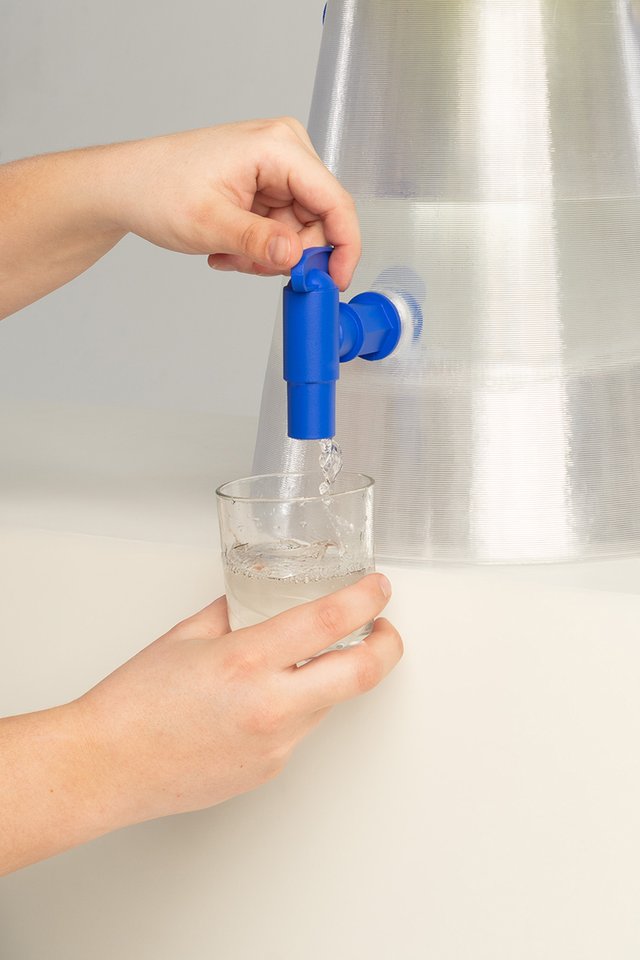Innovative ultralight nanomaterial extracts drinking water from the air/Innovador nanomaterial ultraligero que extrae agua potable del aire

Source
According to official UN figures, approximately 2.2 billion people lack access to safely managed drinking water services, representing more than a quarter of the world's population. The areas most affected by shortages of safe drinking water are sub-Saharan Africa, South Asia, and rural regions in low- and middle-income countries. Water pollution, distance to safe sources, and lack of infrastructure are the main obstacles.
Según cifras oficiales de la ONU, aproximadamente 2,200 millones de personas carecen de acceso a servicios de agua potable gestionados de forma segura, lo que supone más de una cuarta parte de la población mundial. Las zonas más afectadas por escasez de agua potable segura son el África subsahariana, el sur de Asia y regiones rurales de países con ingresos bajos y medios. La contaminación del agua, la distancia a las fuentes seguras y la falta de infraestructuras son los principales obstáculos.
To help alleviate this problem, an international team of scientists has developed an innovative, ultralight nanomaterial capable of ultra-efficiently extracting drinking water from the air, retaining more than three times its own weight in water—a figure that far exceeds current technologies used for moisture capture. This new material is based on graphene oxide intercalated with calcium ions, forming an aerogel, a solid, extremely lightweight, and porous structure.
Para ayudar a paliar este problema, un equipo internacional de científicos ha desarrollado un innovador nanomaterial ultraligero que tiene la capacidad de extraer agua potable del aire de forma ultraeficiente, reteniendo más de tres veces su propio peso en agua, una cifra que supera ampliamente a las tecnologías actuales utilizadas para la captación de humedad. Este nuevo material está basado en óxido de grafeno intercalado con iones de calcio, formando un aerogel, una estructura sólida, extremadamente ligera y porosa.

Source
The synergy that occurs between calcium and graphene oxygen intensifies hydrogen bonds with water molecules, allowing an absorption greater than the sum of its individual components. To release the water obtained, it is enough to heat the material to only 50 ° C, so that the absorbed water is released without the need for large amounts of energy. This makes it ideal for application in areas without electrical infrastructure, since it can be activated with solar energy or other low heat sources.
La sinergia que se produce entre el calcio y el oxígeno del grafeno intensifica los enlaces de hidrógeno con las moléculas de agua, lo que permite una absorción superior a la suma de sus componentes individuales. Para liberar el agua obtenida, basta con calentar el material a solo 50°C, para que se libere el agua absorbida sin necesidad de grandes cantidades de energía. Esto lo hace ideal para su aplicación en áreas sin infraestructura eléctrica, ya que puede activarse con energía solar u otras fuentes de calor bajas.
It allows drinking water to be captured from the atmosphere even in regions where traditional water treatment infrastructure and nearby sources are unavailable. The project was carried out by the Australian Centre of Excellence for Carbon Science and Innovation, the National University of Singapore, and other institutions in China, Japan, and India, under the leadership of experts Rakesh Joshi and Sir Kostya Novoselov. Of all current technologies, this nanomaterial stands out not only for the amount of water captured, but also for the speed of absorption and the low energy cost of releasing the liquid.
Permite captar agua potable de la atmósfera incluso en regiones donde no se dispone de infraestructuras tradicionales de potabilización ni fuentes cercanas. El proyecto fue realizado por el Centro de Excelencia para la Ciencia e Innovación del Carbono de Australia, la Universidad Nacional de Singapur, y otras instituciones de China, Japón e India, bajo el liderazgo de los expertos Rakesh Joshi y Sir Kostya Novoselov. De todas las tecnologías actuales, este nanomaterial destaca no solo por la cantidad de agua capturada, sino por la velocidad de absorción y el bajo costo energético para la liberación del líquido.

Source
This marvelous ultralight nanomaterial is not yet in commercial or industrial use; it is still in the experimental and laboratory validation phase, but there is no evidence that it has yet passed all the stages of testing, approval, or international certification for large-scale applications. The next steps include material optimization, field trials, and the development of functional prototypes, in addition to completing the regulatory and certification processes for mass deployment.
Este maravilloso nanomaterial ultraligero aún no está en uso comercial ni industrial, aún se encuentra en fase experimental y de validación en laboratorio, pero no hay evidencia de que ya haya superado todas las etapas de pruebas, homologación o certificación internacional para aplicaciones a gran escala. Los próximos pasos a dar incluyen la optimización del material, ensayos de campo y el desarrollo de prototipos funcionales además de cumplimentar los procesos regulatorios y de certificaciones para despliegue masivo.
In any case, this innovative nanomaterial has enormous potential. The most obvious application, and one with the greatest social impact, is the supply of drinking water in remote and arid areas without access to water sources, but it can also be used in emergency situations where water infrastructure has collapsed or is nonexistent, both in natural disasters and in areas with ongoing armed conflict. Even scientific, military, or ecotourism expeditions in places without access to water could carry these units for self-supply.
De cualquier forma, este innovador nanomaterial tiene un potencial enorme. La aplicación más obvia y con mayor impacto social es el suministro de agua potable en zonas remotas y áridas sin acceso a fuentes de agua, pero también puede utilizarse en situaciones de emergencia donde la infraestructura hídrica ha colapsado o no existe, tanto en desastres naturales como en zonas con conflictos bélicos permanentes. Incluso en expediciones científicas, militares o de ecoturismo en lugares sin acceso a agua podrían llevar consigo estas unidades para autoabastecerse.
More information/Más información
https://interestingengineering.com/innovation/water-from-air-graphene-calcium-aerogel